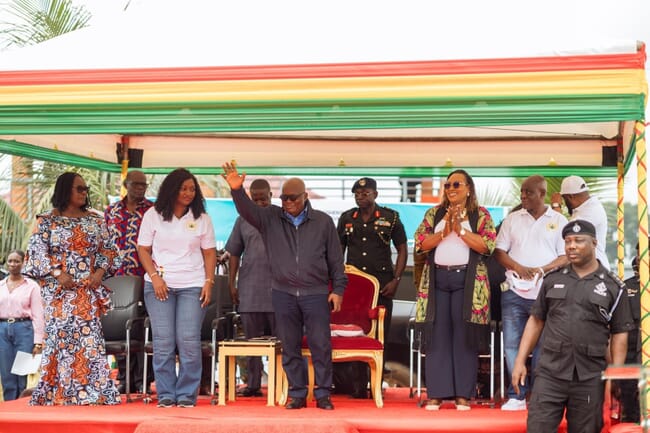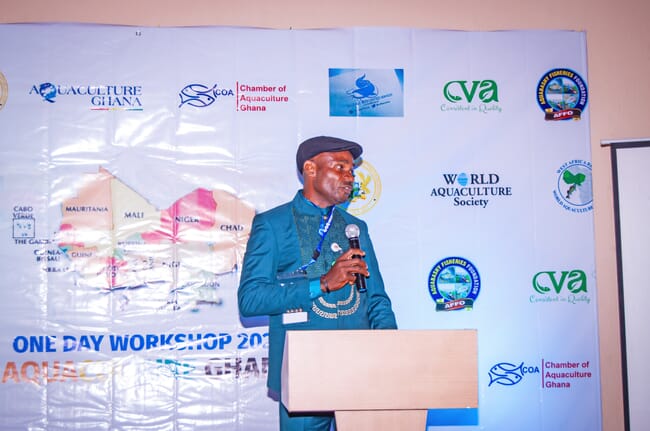
Called the Aquaculture For Food and Jobs programme, it was officially launched at R and B Farms at Nsuaem in the Central Region, on 31 July.
The programme aims to contribute 20,000 tonnes of fish per year, create 60,000 jobs across the aquaculture value chain and contribute $40 million to GDP.
Prior to the official launch, a training of trainers workshop was run at R and B Farms, at which 30 trainers were prepared to deliver a well structured modular training package to 10,000 beneficiaries, to enable them operate viable ventures. The beneficiaries will receive regular support and monitoring.
President Akuffo-Addo said: “Aquaculture has been identified as a sector with immense potential. As a nation blessed with vast water bodies, its only prudent that we make concerted efforts to exploit these resources efficiently. The Aquaculture for Food And Jobs programme is designed to do just that… By developing a robust aquaculture industry, we are ensuring food security and creating employment opportunities, particularly for our youth.”
“In Ghana, fish is a staple in our diet, contributing substantially to our nutrition intake. However the demand for fish far exceeds the supply, leading to a reliance on imports which drains our foreign exchange reserves. In 2022 for instance, Ghana’s total fish requirement was some 1.3 million tonnes. However our domestic production was some 657,000 metric tonnes, necessitating the import of some 650,000 tonnes of fish with a total value of $311 million to ensure food and nutrition security. This reliance on imports underscores the critical gap we face in meeting our nation’s fish consumption needs. The Aquaculture for Food And Jobs programme aims to reverse this trend by boosting fish production in Ghana. By doing so, we will reduce our dependence on imported fish, keep our hard earned foreign currency for other important activities, and ensure that our people have access to fresh, locally produced fish.”
Ghana’s Minister for Fisheries and Aquaculture Development, Mavis Hawa Koomson, said that the cost of equipping each beneficiary for six months, including a monthly allowance, is 38,000 cedis ($2,444).
Increasing demand
Prof Berchie Asiedu, dean of the School of Natural Resources of the University of Energy and Natural Resources, warned on 10 July that a decline in national fish output will trigger hunger and malnutrition among many Ghanaians by 2030. He said that fish has been the country's cheapest and most consumed animal protein, comprising 60 per cent of consumption and growing from 960 tonnes in 2010 to 1.1 million tonnes in 2020.
During that same period, he said, per capita fish consumption had increased from 24.2 kg to 27.9 kg. However, national fish output in 2030 would only comprise 43 per cent of demand, and many people would be compelled to eat less fish, with obvious implications for nutrition and food security.
However, other experts are confident that whilst Prof Asiedu’s warning is a useful call for increased aquaculture production, the aquaculture sector is making some modest growth, in spite of last year’s floods on Lake Volta, which destroyed numerous fish farms. This is in part due to the growth of the catfish sector.
As Hanson Dzamefe, Bono regional director of the Fisheries Commission, noted: “Catfish production is making good progress in Ghana, and will approach tilapia production in only a few years”.
The National Aquaculture Development Plan is targeting a doubling of annual aquaculture production, from the current level of 132,000 tonnes, by 2027.

Smaller fish, bigger profits?
Another interesting trend is the move towards the production of smaller fish, rather than the large ones favoured by point-and-kill catfish grill joints, which typically serve grilled spicy catfish of one kilo and above with rice or chips. But farmers are heeding the advice of experts that production of tilapia and catfish between 300 and 600 grammes makes better economic sense.
As John Domozoro, CEO of PBA Fish Farm, reflects: “One can understand the farmers who are targeting the grill joint and big event markets, but the market for small and medium sized fish is bigger. Domestic consumers can afford smaller fish, smoked or fresh. It is instructive to note that in Egypt, the biggest aquaculture producing nation in Africa, large size fish are virtually unknown.
And at a recent workshop in Accra, the President of the Catfish Farmers Association of Nigeria, Sunday Onoja, said that: “West African fish farmers should remember that their primary customers are home consumers who prefer smaller size fish. They far outnumber the other customers. We can produce more profitably when we target them.”




